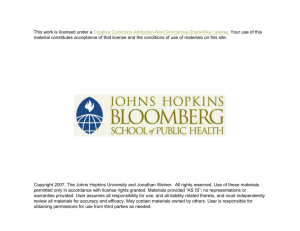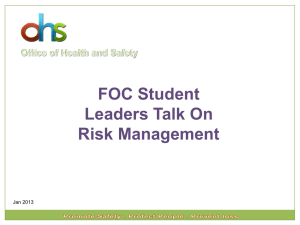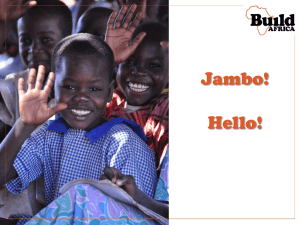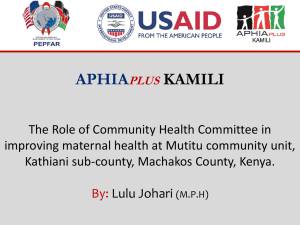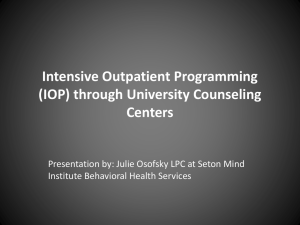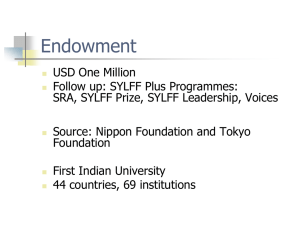Capitation Case Study & Proposal
advertisement
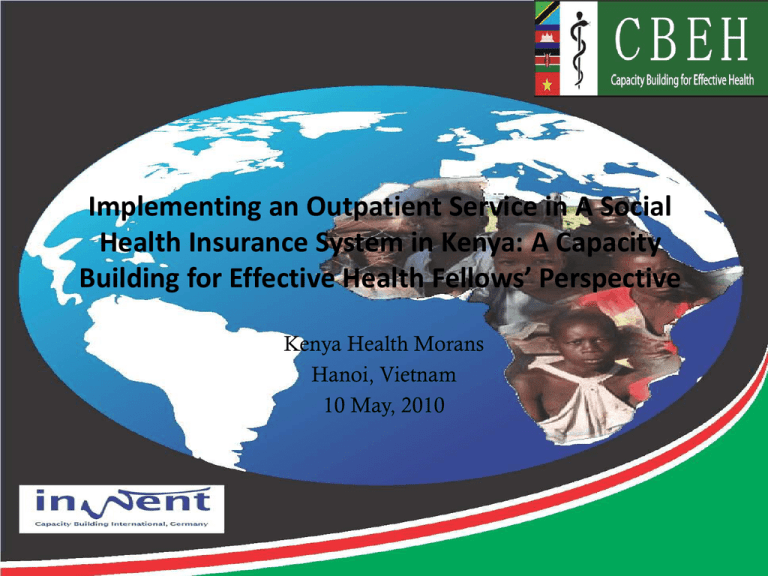
Implementing an Outpatient Service in A Social Health Insurance System in Kenya: A Capacity Building for Effective Health Fellows’ Perspective Kenya Health Morans Hanoi, Vietnam 10 May, 2010 PROJECT OPTIONS Option 1: Research question Can capitation assure quality of healthcare and reduce out of pocket expenditure for the poor and vulnerable in Kenya? Option 1 Justification • Will offer new perspective to HF reforms. Previous reforms have focused on resource mobilization • Addresses targeting shortcoming in NHIF outpatient pilot which does not cover poor and vulnerable • Experiential approach advocated as a powerful way of testing PPMs • Inform the design of the planed HFT pilot • Develop field internship sites for CBEH programme – Field internship sites will give CBEH Fellows the practical experience necessary to complement didactic training, while giving the health institutions new resources to improve management analysis. Project Goal • To contribute to the improvement of the health status and quality of life of all Kenyans, especially the poor and vulnerable groups. Project Objectives • Assure quality of outpatient services • Reduce the OOP spending on OP services by Mathare residents Capitation Project Cost Estimate Target Population % of Population that is poor No. of Visits per person in 1 year No. of Visits in 6 Months Total No of Visits during Project Period Estimated Cost per visit Target No. of service Providers Average Number of Clients/Day/Provider Contribution from Insured members/Pooled funds Contribution for Poor/Vulnerable Project Management Costs Total 5,000 46% 4 2 10,000 600 5 These 11 are order of magnitude estimates to be fine tuned 3,240,000 2,760,000 2,000,000 8,000,000 Assumptions • • • • Funding and Stakeholder Support Provider buy in. Provider Management and Clinical Capacity Availability of an Implementation Team Success Criteria • Capitation project implemented • Providers compliance with agreed treatment guidelines • Increased client satisfaction with outpatient services • A reduction in outpatient out of pocket spending Project implementationChallenges • • • • Funding Buy-in from stakeholders Duplication of efforts- three pilots plannedAcceptance by the potential beneficiaries Option 2: Research question • Can capitation assure quality of healthcare and reduce out of pocket expenditure for the poor and venerable Kenya? Option 2 Project Approach • Same as for option 1, but piggy back on NHIF’s pilot. • NHIF will provide funds for members • Fellows will seek support for funding of indigents Option 2 Pros • Will have benefits of option 1, but to a limited extent Option 2 Cons • Stakeholder buy-in ( NHIF and funder of indigents) • Perceived conflict of interest with private sector Fellows • Logistics of changing project design to accommodate poor and vulnerable population • Fellows will have no control over time, scope and quality, key tenets of project management • There may be no results to report at evaluation seminar in Hanoi, Vietnam Option 3: Research Question • What are the critical factors for the successful implementation of capitation in out patient services for primary health care? Option 3 Project Approach • Literature review of implementation of capitation in a number of countries, both developing and developed • Identification and critical analysis of critical success factors • Project documentation • Development of implementation manual Option 3 Pros • Well thought out actionable plans for successful introduction of outpatient services under a social health insurance system Option 3 Cons • Lacks experiential approach of Options 1 and 2 • Limited documented experience of capitation in developing countries Implementing an Outpatient Service in A Social Health Insurance System in Kenya: A Capacity Building for Effective Health Fellows’ Perspective Assumption • This paper assumes that there are enough revenues to provide individuals with a basic package of essential out patient services and financial protection against catastrophic medical expenses caused by illness and injury in an equitable, efficient, and sustainable manner. Methodology • Development of this paper was based information obtained from : • Literature review • Formal and informal meetings with health systems and health financing experts. Benefit Package • The benefit package important consideration in the uptake of health services under SHI • Benefit package must be economically feasible, and socially acceptable • Based on KEPH and WHO 2008 report • Research on regional epidemiological profiles to inform definition of benefit packages. • Carry out study to collect expectations of a minimum health benefit package • Will evolve over time Cost Management • Costs of benefit package will determine the financial sustainability and survival of outpatient coverage. • Use GTZ costing tool to cost service, triangulate with capitation rate calculator • Carry out market survey to determine OP service delivery costs • Obtain win-win situation • Control service delivery costs through use of clinical standards and treatment protocols • Manage administrative costs – outsourcing and process improvement • Aim at not exceeding 10% of throughput Players in OP Service Delivery • Palyers include – Risk Pooling Agency – Purchasing agencies – Service Providers – Beneficiaries • Separation of functions; NHIF to do risk pooling. Purchasing of OP services to be done by appointed service managers Capitation Service Manager • • • • Competitive selection process Competition to increase efficiency Selection should be based on: Critical skills and competencies – Financial and accounting experience and HR capacity – Systems- ICT, membership/claims/accounts payable/customer service, audit, reporting – Health Sector Experience • Draw up contract. Adapt from existing private sector documents. Service Provider • Selection criteria should be based on: – Location/Accessibility – Physical capacity – HR mix – Range of outpatient curative and Preventative services offered – Turnaround time(and customer service) – Quality assurance (clinical and non-clinical) – Integrity – Clinical Risk management – Cost management – Medical infrastructure – Accounting and Record Management systems • Apply franchising principles to develop provider systems • Contract to manage purchaser/provider relationship Member Recruitment • Identification of poor- Tool adapted from OBA/UNICEF and GOK Poverty identification tool. • Classify poor according to serverity; government will first pay premiums for the most poor and progressively increase this coverage with time to cover all those identified as being poor. • Members should have some choice to select their service provider • Recruitment process can borrow a lot from voter registration process Member Recruitment • Employ various strategies to disseminate information on member registration.,this should include: – posters at chief camp and health facilities, – newspaper advertisement, – brochures issued in learning centres and at the market place. • Based on available budget consider use of and sophistication of the required electronic data base, biometrics automated methods of recognizing the member recruited will be applied. Communication (1) • Communication will play a critical role in the success of the out patient scheme. • Develop communication strategy to explain SHI principles including solidarity • Important to build consensus in favor of social health insurance. • Stakeholders – Government – Health financing stakeholders (GTZ/MOMS/MOPHS/INWENT/health financing strategy taskforce members/NHIF) – Development Partners – Private sector – The media – Members of the general public, the beneficiaries of the out patient service – Service providers – Local administration – Community health workers/social health workers Communication Matrix (2) Symbol R A C I Action “The Doer” Function/role The “doer” is the individual(s) who actually complete the task. The “doer” is responsible for action/implementation. Responsibility can be shared. The degree of responsibility is determined by the individual with the “A”. “The Buck Stops The accountable person is the individual who is Here” ultimately answerable for the activity or decision. This includes “yes” or “no” authority and veto power. Only one “A” can be assigned to an action. “In the Loop” The consult role is individual(s) (typically subject matter experts) to be consulted prior to a final decision or action. This is a predetermined need for two-way communication. Input from the designated position is required. “Keep in the This is individual (s) who needs to be informed after a Picture” decision or action is taken. They may be required to take action as a result of the outcome. It is a one-way communication Communication (5) • Communication will happen concurrently and/or sequentially as per the need. • E.g. first communicate to and finalize contracts with the service providers/facilities before we communicate with the potential beneficiaries asking them to present themselves for registration Communication (3) • Channels to be used include: – Above the line- this will be of limited value if anything. Examples of this type of communication are billboards, newspaper adverts etc – Below the line- these are brochures, flyers and other amphlets. These will be used especially for communicating to the beneficiaries of the scheme. – Public forums eg churches, ghetto radio FM etc. this will be used depending on the target audience. It will be an important modality since it lends credibility to the process and promotes understanding of the scheme benefit package. Communication (4) • Key Messages to be Communicated – Purpose/benefit of insurance – Recruitment start and finish – Funding partners – Benefit package – Periodic updates on how the project is doing – Forums for the recruitees to air their views on the benefits – Report:- type/frequency and templates to be agreed Communication (5) • Other Issues to be considered – Language to be used in the communications materials – Use of pictorials to enhance effective communication to the target audience especially the beneficiaries. – Secretariat:communication tools such as telephones, internet connection, computers etc Quality Management • Quality of service delivery important for the success of out patient scheme • Quality Management Plan will encompass – Management and Facility Quality • Ownership and leadership • Facility infrastructure, plant and equipment. • Enterprise management systems • Regulatory and Legal Compliance – Clinical Quality • Clinical Standards • Performance Management • Client Satisfaction Quality Management • The Quality management will build on existing systems such as – Clinical standard guidelines – Kenya Quality Model – The National Hospital Insurance Fund (NHIF) Master Check List for outpatient services providers – Various private sector and non-governmental organizations’ quality standards. Risk Management • Should involve – Risk Identification; – Risk Quantification; • Use the Failure Mode and Effects Analysis model. Risk Value = Impact x Probability x Detection. Where: Impact measures the severity of the risk on the project; Probability measures the likelihood of the problem occurring; Detection is defined as the ability of the project team to discern that the risk event is imminent – Risk Response; – Risk Monitoring and Control Assessment • Risk management should be iterative and participatory Risk Management Matrix Possible Failure Effects of Mode Failure Cause of Failure Impact Probability Ease of detection Risk Value Risk Response Plan Other Support Systems: Commodity Management • The availability of medical commodities plays a critical role in the access of health care services and enhancing the quality of health care delivery. • Use of public health facilities is directly related to the availability of drugs and other medical supplies • Focus on areas where there are the biggest opportunities for improvement that will deliver the highest impact on the delivery of health services. – Selection of essential medicines and medical commodity list – Pooling of procurement by private sector providers – Distribution – explore Public Private Partnerships Other Support Systems: Refferal System • OP services usually offered at level 2-3, however, recruited members may present emergency or non emergency health situations that require interventions in health facilities under level 4-6 for specialized care • Benefit package to include ambulatory services • Define refferal protocol • Consider using PPP • Use existing networks e.g. St. John’s • Establish call centre to coordinate refferal service M&E • M&E important for evidence-based decision making. M&E should include: – Financing options – population covered – benefits package – provider engagement – organisational structure – Operational processes • Monitoring should be continuous • Need to define indicators • Do both baseline and tracking surveys Challenges • • • • • “Big brother” influence from GTZ Reluctant “default” champion Perceived competition Lack of Funding CBEH not a legal entity – Manage fund – Research Permits • Time pressure- 1st and last quarter of the year a major challenge for most participants- planning & Budgeting • Research and writing skills Achievements • NHIF agreed to incorporate capitation as an alternative PPM in addition to FFS • Stakeholder interactions and support especially from GTZ • Increased understanding of PPM and impact on success of SHI • Gained HF knowledge • Better understanding of the health sector documents • Improved Private Public interactions within the group:- a better appreciation by both sides Acknowledgements • GTZ Kenya Health Progamme • KfW, Kenya • InWEnt Team – – – – – – – – Alice Amayo Konrad Obermann Norma Lange-Tagaza Seynabou Fachinger Svetla Loukanova Tanja Schwering Thorsten Körner Ute Schwartz • Health Financing Stakeholders • Employers • Families Thank You Asante!
